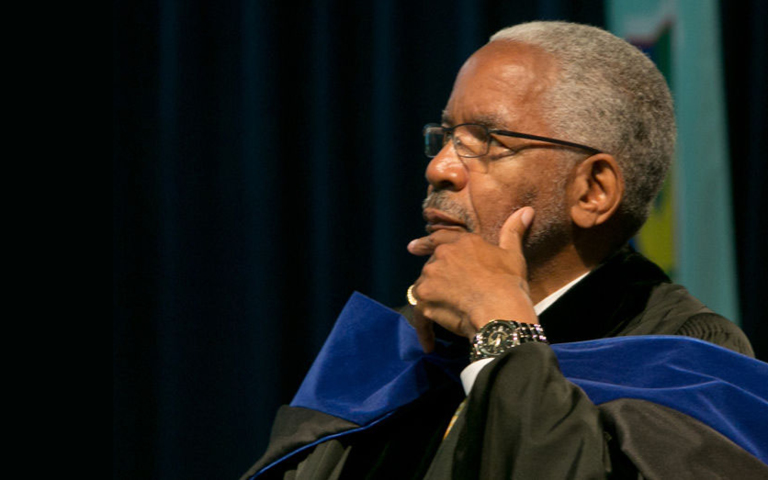As the U.S. reckons with its racial inequality of the past and present, the ACR is exploring how it can leverage its own advocacy network to create a future of healthcare equity. The Bulletin talked with Henry W. Wiggins Jr., MD, a Black radiologist and civil rights activist, about his early experiences in the profession.
How did you get your start in radiology?
I remember being a high school senior in Clearfield, Pennsylvania, in 1951, when my entire class got to go to Washington, D.C., but I couldn’t go because restaurants and hotels in Washington D.C., at that time, refused to serve Black Americans. I was the only Black intern at University Hospital, Iowa City, from 1959–1960. I was an internal medicine resident from 1960–1961 and a radiology resident from 1961–1964. When I was at Michael Reese Hospital in Chicago from 1964–1966, I was the only Black radiologist on staff.
I was drafted into the U.S. Navy and relocated with my family to serve at the San Diego Naval hospital as Lieutenant Commander during the Vietnam War from 1966–1968. During the first few months, I made several calls to look at available housing — only to be told that nothing was available when I showed up in person. This obvious racism affected my ability to do my job and the well-being of my family.
Later, I was transferred to Bremerton Naval Hospital in Washington. When I arrived at the hospital for the first time, I was mistaken for Dr. Bryant, the other Black physician on staff, which was bittersweet. On the one hand, it was disheartening to be mistaken for another Black doctor. On the other hand, I was glad that for once I wasn’t going to be the only one on staff.
In your 1965 Postscript essay, “Freedom: Spirit of the Selma March,” you wrote about your participation in the march from Selma to Montgomery. How did this experience change you?
Being around other people who were doing the same thing, for the same reasons I was, ignited a new chapter in my life. There weren’t only Black folks there — there were people of all races, from all over the country. I discovered that the reasons I was marching were relevant and important to a broad spectrum of people — not just to me and my community. That’s why I also participated in the Million Man March in Washington, D.C., in 1995.
How do racial disparities in healthcare continue to be a public health crisis for Black communities?
There is a shortage of Black physicians. For Black families, this may mean that they can’t see a physician they feel comfortable with or who understands their culture. But disparities in healthcare don’t just affect Black communities. They affect Native Americans, Latinxs/Hispanics, people from different socioeconomic groups — everyone who lacks representation in the profession.
Why do you think radiology lags behind other medical specialties in its percentage of Black physicians?
Medicine in general lacks representation of Black physicians, not just the field of radiology. And one can’t talk about this without considering the effects of the Flexner Report of 1910, a landmark study of medical education in the U.S. and Canada.
The medical school closures that occurred as a result of this report disproportionately affected schools at Historically Black Colleges and Universities (HBCUs). Of the seven medical schools at HBCUs, five were closed. Because of widespread admissions discrimination at the time, it was almost impossible for aspiring Black medical students to study anywhere else.
During the ‘50s and ‘60s, plenty of Black students applied at all medical schools, not just the ones at HBCUs. They just weren’t being accepted. It became commonly known in the community that we weren’t being accepted elsewhere. Looking back, I knew very few Black physicians who studied at other medical schools. The resulting shortage of Black physicians continues today and extends to radiology.
Medicine in general lacks representation of Black physicians, not just the field of radiology.
Although the overall number of Black male college graduates has increased, the number of Black male medical students has actually decreased since 1978. Why do you think this is?
I think there are a lot of factors involved in decreased enrollment. Cost is one of them. Lack of representation in medicine is another, because many college students won’t choose to study something in which they don’t see themselves represented.
The National Medical Association (NMA) was created in 1895 to serve Black physicians who were not permitted to join the AMA at that time. I used to do recruitment tours on behalf of the NMA to help spark interest in a medical career among students of color.
I also used to host the NMA section at RSNA, with Black radiologists, residents, and medical students in attendance. That proved to be a good venue for recruiting Black medical students into radiology.
Targeted radiology internships and mentorship programs are also a way to attract more URM physicians to radiology. It may be beneficial to expose students of color to careers in medicine at an even earlier age — in high school or middle school.
How might the radiology community address and eliminate implicit bias?
Implicit bias needs to be discussed more often — in our CME, at our conferences — to the point where everyone is aware of their own biases. We all have them.
Medical students need training, and early, about what implicit bias is, how to recognize and challenge their own biases, and how to ensure those biases don’t spill over into their practices. In patient care situations, this is critical, and sometimes it is literally a matter of life or death. While I don’t have concrete solutions for inclusion, what I do know is that we as a profession have to talk about it. Hopefully, conversation will lead to action that improves health equity and representation within our field, to the benefit of the patients we serve.

